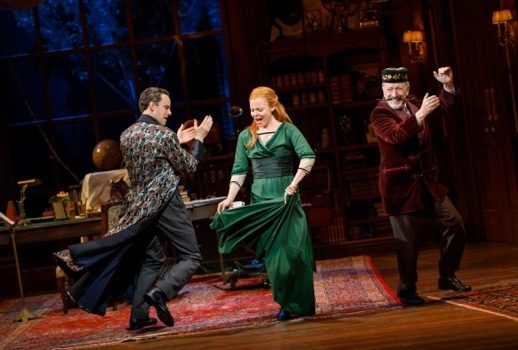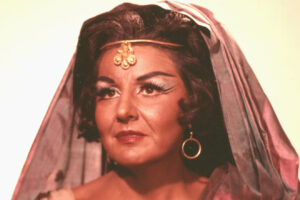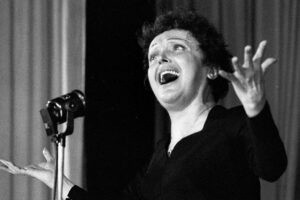

Mainly plain.
In Pygmalion, and, by extension, in My Fair Lady, George Bernard Shaw packed a multitude of important social issues—class, privilege, feminism, morality and gender roles among them—into a light comedy. Sadly, a revival of the 1956 musical at Lincoln Center makes a muddle of the show’s thoughtful elements and isn’t particularly funny either.
I saw the show Saturday afternoon and I can report it is big and impressive and (fitfully) glitzy and includes some winsome performances, in particular from an archly underplaying Diana Rigg as Mrs. Higgins. The music sounds handsome as played by an extravagantly full-sized orchestra. But the show lacks a Big Idea, or rather, the Big Ideas inherent in the piece seem to have been shunted aside to make way for an Idea currently on a lot of people’s minds but only intermittently supported by the text.
That Idea, of course, is the thesis of the “Me Too” movement, i.e., that women are systematically abused in society and especially in the workplace. No one with any sense doubts that is a grave problem, and reviewers of this production have generally mentioned it in connection with this revival.
The trouble though, is that nothing that happens to Eliza in the course of the musical can quite be defined as “abuse.” No one makes an unwelcome sexual advance at her, no one raises a hand to her physically (or shouldn’t, anyway, but more on that in a moment) and nobody says a cross word to her—until the penultimate scene, when the clueless Higgins mistakes her hurt pride for ingratitude.
The dramatic crux in Pygmalion—and presented even more emphatically in My Fair Lady—is the successful challenging of the theme of the underlying “Pygmalion” myth, i.e., that a successful woman is a Creation, as engendered or at least meticulously polished by a male Creator.
Curiously, even though Shaw very neatly dispelled this fallacy more than a century ago, the “Man Teaches Woman How to Be a Woman” trope has continued to thrive in popular entertainment.
It may be Claude Rains drilling Miriam Hopkins:
Or James Mason advising Judy Garland to chuck the singing career and take up acting:
Or basically any rom-com in which the heroine has a sassy gay friend:
Now, it may sound like a digression if I say that, so far as I see it, My Fair Lady is, in fact, a rom-com in which the heroine has a sassy gay friend, but maybe that’s no digression at all. For my money, the most radical Big Idea posited in this show is the notion that a man and a woman (even a Creator and his Creation) could build a satisfying and even vital relationship that is based on neither sex nor romance.
Is it possible for a man and woman to be friends, and therefore necessarily equals?
Shaw certainly seems to have thought so: he wrote an epilogue to the play insisting that although Eliza married Freddy, she spent her quality time at 27A Wimpole Street bossing, needling and generally hanging out with Higgins. Indeed it seems more than fair to read this epilogue as an endorsement that the Eliza-Higgins affiliation (for it is a lot more complicated and a lot less peaceful than a mere friendship) is the most important and fulfilling relationship either of them will ever know. (“[S]he has a sense, too, that his indifference is deeper than the infatuation of commoner souls. She is immensely interested in him.”)
My Fair Lady is a comedy, and like many of the greatest comedies, its deepest theme is reconciliation. Eliza walks out, yes, but this is not A Doll’s House; in a comedy, walking out is only preparation for a return. This final dramatic action Shaw suggested in his epilogue Anthony Asquith made more explicit in his 1938 film based on the play.
In the musical, Alan Jay Lerner and Frederick Loewe sentimentalize this scene more than a little, but it’s still “Eliza Returns.”
That Eliza does return, and on her own terms, to a repentant Higgins, despite his various past misbehaviors is to my mind the biggest of all the Big Ideas in this show: Eliza Magnanimous in Triumph. (That’s practically the title of a baroque oratorio.)
But that’s not director Bart Sher‘s idea of a Big Idea, apparently. Eliza (Lauren Ambrose) takes the trouble to hoof it across town to Wimpole Street, walking in the reverie of a bereft Higgins (Harry Haden-Patton) but explicitly rejecting the idea of reconciliation. They stand staring at each other for what seems like a quarter of an hour after the “slippers” line, and finally Ambrose turns, breaks the fourth wall and runs ecstatically up the aisle of the theater.
That is to say, she not only walks out of Higgins’ life but out of the play itself. She escapes from the past into our present, where she has no need for Higgins and, apparently, we have no need for My Fair Lady.
Now, there may be a case to be made that My Fair Lady is antiquated and obsolete, and certainly in 2018 the dramatic motif that “if you bully a woman long enough, she’ll grow into as good a human being as any man” could used some major unpacking. But this kind of intellectual heavy lifting is not what Bart Sher does.
He’s been a very sweet and sincere guy on the occasions when I’ve met him briefly at the theater, and he does have some important strengths as a director. He respects the text and he has a real gift for devising details of business that both look good on the actor and support the broader concept.
What he’s not, though, is a Big Idea guy. This My Fair Lady progresses more or less like every other revival of the show in the past six decades until the penultimate scene, here enriched with a few extra bits of Shaw but played with a vehemence we might more closely associate with Ibsen.
In the climax of the scene and the great moment of peripeteia in the entire drama, Eliza taunts Higgins by claiming that, using the knowledge she has gleaned from their lessons, she will become the assistant of his rival, Professor Karpathy.
HIGGINS: You take one step in that direction and I’ll wring your neck. (He almost does.) Do you hear?
ELIZA: (Defiantly) Wring away! What do I care? I always knew you’d strike me one day!
Now, surely the point here is that Higgins momentarily loses his vaunted self-control, and Eliza declares victory. She has bested him at last! But in Sher’s production, Haden-Patton actually tries to throttle Ambrose, and she breaks away, gasping in pain and terror. There is no reversal and the rest of the play makes no sense.
Now and then I wondered if Sher was perhaps trying to play My Fair Lady as a concept show. There’s this enormous set piece on a stage-spanning wagon depicting not just Higgins’ overstuffed study but several rooms of his house through which Eliza stomps while singing “Just You Wait.” Is it meant to symbolize the professor’s rampant, oppressive male privilege, imprisoning Eliza as if she were a lab rat in a bell jar?
Her final exit tends to support this interpretation, but then why would she step out of the set (“escape”) so frequently earlier in the evening? And how can one relate this one gargantuan set piece to the sparseness of scenery everywhere else in the show? Covent Garden, Doolittle’s pub and even Ascot were depicted with a few disjointed flats and bits of furniture like something from one of the lower-budgeted episodes of The Judy Garland Show.
The performances are similarly scattered. Ambrose whines and pouts and sighs and otherwise secretes passive aggression as Eliza. Haden-Patton seems always to be afraid of making a mistake. He never does, really, but he comes off as more than a little timid, which paradoxically seems to make his bullying seem meaner and more devious. And, as Doolittle, Norbert Leo Butz is in a completely different show, something like Zero Mostel in Hallelujah, Baby! only somewhat broader.
It seems at the moment you can’t revive My Fair Lady, even at Lincoln Center Theater, without questioning its underlying assumptions in light of current political thought. That is by no means a bad thing: every text, especially the classics, needs to be confronted. The problem with his revival is that Bart Sher is not, by nature as an artist, a confrontational guy.
I’d love to see what Rachel Chavkin could do with this show.
Photo: Joan Marcus
Reach your audience through parterre box!
parterre box, “the most essential blog in opera” (New York Times), is now booking display and sponsored content advertising for the 2023-2024 season. Join Carnegie Hall, Lincoln Center, Warner Classics and many others in reaching your target audience through parterre box.
parterre box, “the most essential blog in opera” (New York Times), is now booking display and sponsored content advertising for the 2023-2024 season. Join Carnegie Hall, Lincoln Center, Warner Classics and many others in reaching your target audience through parterre box.
-
Topics: bartlett sher, big ideas, review, thinking
Latest on Parterre
Call for submissions: parterre box‘s new Talk of the Town
parterre box is launching a new themed regular feature curated by our readers and opera fans across the world! We are asking for your favorite clips, recordings, and anecdotes to get people chatting, listening, and thinking.
parterre box is launching a new themed regular feature curated by our readers and opera fans across the world! We are asking for your favorite clips, recordings, and anecdotes to get people chatting, listening, and thinking.
parterre in your box?
Get our free weekly newsletter delivered to your email.

























Comments